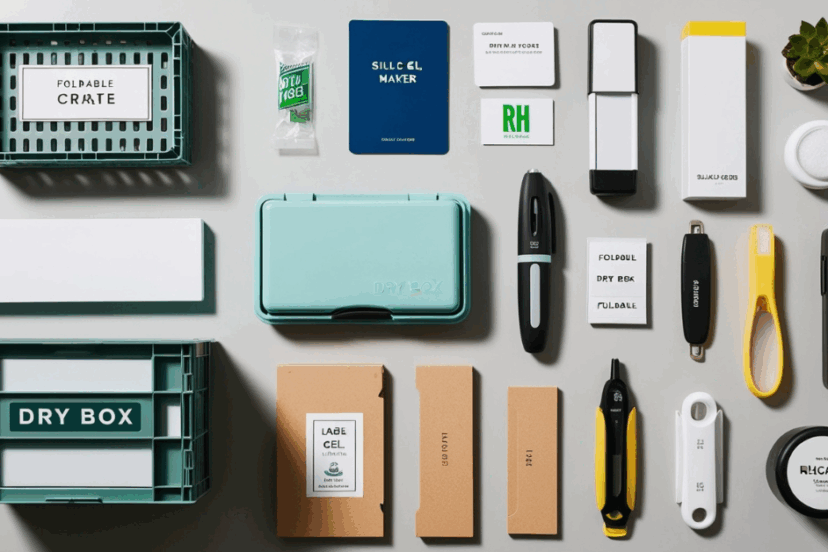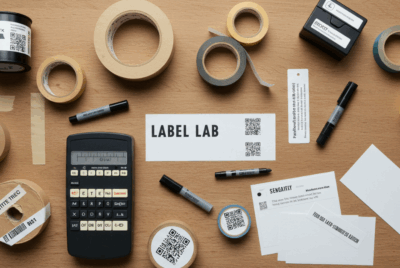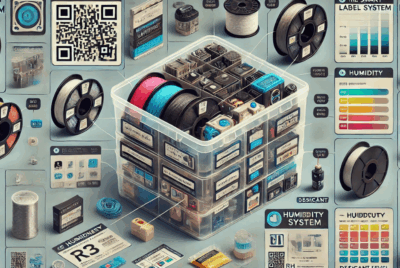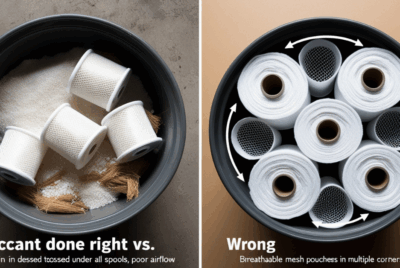What’s the Best Filament Storage Setup for a Small Workspace?
1. Introduction: Small Space, Big Filament Headaches
You’re passionate about 3D printing… but your workspace is, well, tiny.
Sound familiar?
Spools are stacking, tools are scattered, and there’s no room to breathe.
The good news? You don’t need a full workshop to store filament safely and smartly.
Let’s build the best filament storage setup for small spaces—without sacrificing print quality.
2. Why Storage Gets Tricky in Tight Work Areas
Filament spools aren’t huge, but they add up fast. And each one needs:
- A low-humidity environment
- A way to stay sealed
- Easy access when needed
- A system you can actually keep up with
Without a system, your workspace becomes a filament jungle.
3. The Top Goals for a Small-Space Setup
✅ Protect filament from humidity
✅ Organize your collection
✅ Save space vertically or compactly
✅ Easily rotate and access spools
✅ Label and track usage
If your setup checks these boxes—you’re golden.
4. Assessing Your Real Storage Needs
Ask yourself:
- How many spools do I have open?
- How many are in regular use?
- Do I rotate filament types often (TPU, PETG, PLA)?
- What’s the average humidity level in your space?
This helps decide whether you need:
- A few compact vacuum bags?
- A dedicated dry box?
- Or a hybrid solution?
5. Storage Option #1: Vacuum Bags with Silica Gel
Best for: Storing unused or backup filament
- Takes up minimal space
- Spools stack easily on a shelf or drawer
- Keeps air out and humidity low
- Great for long-term protection
Pair with:
- Color-changing silica gel
- Humidity cards
- Label with last dried + opened date
Top kits:
- eSun Vacuum Storage Kit
- Dry & Dry Hand Pump Bag System
Pro tip: Store these bags vertically in a crate or bin to save space.
6. Storage Option #2: Stackable Airtight Bins
Best for: Semi-active spools or multi-filament collections
Look for:
- Gasket-sealed lids
- Stackable design
- Room for 3–6 spools
- Space for silica + hygrometer
Popular options:
- IRIS Weathertight Storage Boxes
- Sterilite Gasket Boxes
- Modified shoe bins
Slide these under desks, beds, or shelves for hidden but accessible storage.
7. Storage Option #3: Vertical Wall Mount Racks
Best for: Super small rooms with available wall space
Use pegboards or wall-mounted spool holders to:
- Get filament off the floor
- Free up desk space
- Create a “display” system for color options
⚠️ Just remember—this is NOT sealed storage
Use it only if you’re printing regularly, or combine it with dust covers or dry boxes.
8. Storage Option #4: Desktop Dry Boxes
Best for: Active filament you print with weekly
Choose one of these:
- SUNLU S2 Filament Dryer
- eSun eBox Lite or Pro
- PrintDry Pro
Benefits:
- Keeps your current spool dry
- Prints directly from the box
- Compact footprint (fits on most desks or shelves)
- Internal RH display
Ideal for limited-access, small print stations.
9. Multi-Spool Drawer Systems
Have a rolling cart or a spare drawer cabinet?
Turn it into a filament station:
- Add humidity cards
- Toss in silica gel
- Line drawers with foam or dividers
- Label each slot
If drawers are airtight, it’s a bonus. If not, use vacuum bags inside each drawer.
10. Hidden Storage Hacks (Under-Desk, Wall Crates, etc.)
Small space = get creative.
Ideas:
- Under-desk hanging bins
- Wall-mounted milk crates with clear fronts
- Over-door shoe organizers (for tools + silica)
- DIY drawer inserts for filament tools + desiccants
Maximize every inch of vertical and hidden space.
11. Labeling and Tracking Dry Dates in Small Spaces
Don’t lose track of what’s dry or open.
Use:
- Colored masking tape
- Mini whiteboard labels
- QR code tags with info
- Stickers with “Dried on: ____” and “Opened on: ____”
Visible tracking avoids guesswork—and wasted filament.
12. Using Foldable or Modular Storage Tools
If your space is ultra-flexible:
- Use foldable crates or containers
- Modular bins that slide into a closet
- Stackable mini drawers with pull-out trays
Adapt your system to your space—not the other way around.
13. Space-Efficient Humidity Monitoring
Try:
- Mini digital hygrometers like ThermoPro TP49
- Bluetooth RH sensors like Govee Mini
- Humidity cards for bins or vacuum bags
Store one per zone.
Check RH weekly, especially during seasonal humidity swings.
14. Setup Examples for 3, 6, or 10+ Spools
| Spool Count | Recommended Setup |
|---|---|
| 1–3 | Desktop dry box + vacuum bags |
| 4–6 | One airtight stackable bin + RH cards |
| 7–10 | Mix of wall rack + vacuum storage |
| 10+ | Rolling drawer system + overflow sealed containers |
Build a tiered system:
- Frequently used = quick access
- Rarely used = long-term vacuum storage
15. Final Thoughts: Your Setup Should Work With Your Space
Small workspaces don’t mean you have to sacrifice organization—or quality.
You just have to get a little creative and a lot intentional.
✅ Use vacuum bags for backups
✅ Keep dry boxes for actives
✅ Label everything
✅ Track humidity regularly
✅ Use walls, under-desks, and drawers
When every inch counts, a smart system = a smooth print.
❓FAQs
- Can I store filament in a drawer without sealing it?
Only if the drawer is airtight and includes desiccant + RH monitoring. Otherwise, use vacuum bags inside the drawer. - Are wall racks good for filament storage?
Only for short-term use or active spools. They’re not humidity-proof unless sealed. - What’s the best setup for 3–5 open spools?
Use one airtight bin with silica gel and a humidity card. Stack vertically to save space. - Can I use kitchen vacuum bags for filament?
Yes—just make sure they’re large enough and fully sealed with desiccant packs inside. - Do I need a hygrometer for every container?
Not necessarily. Rotate one between bins weekly or use color-changing humidity cards instead.




